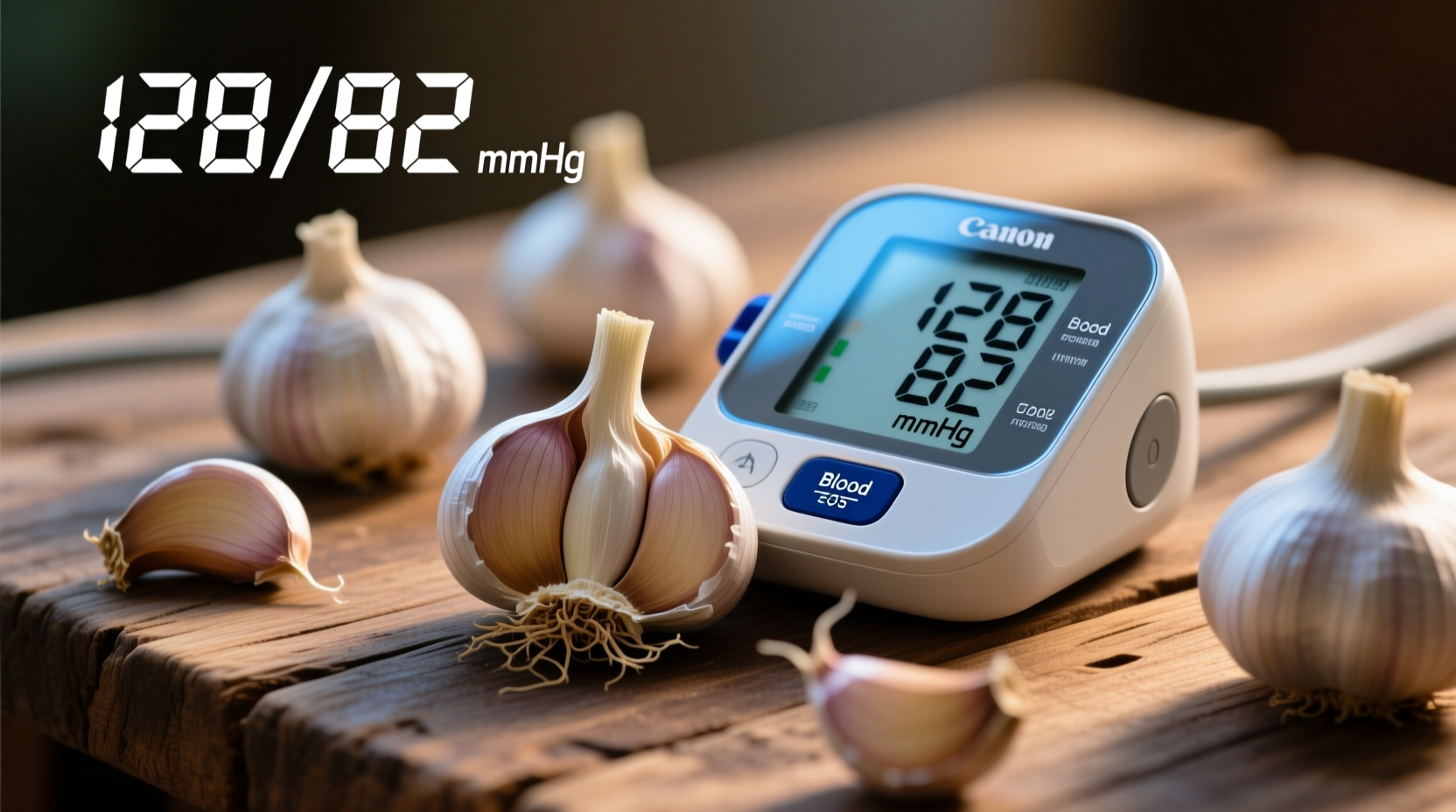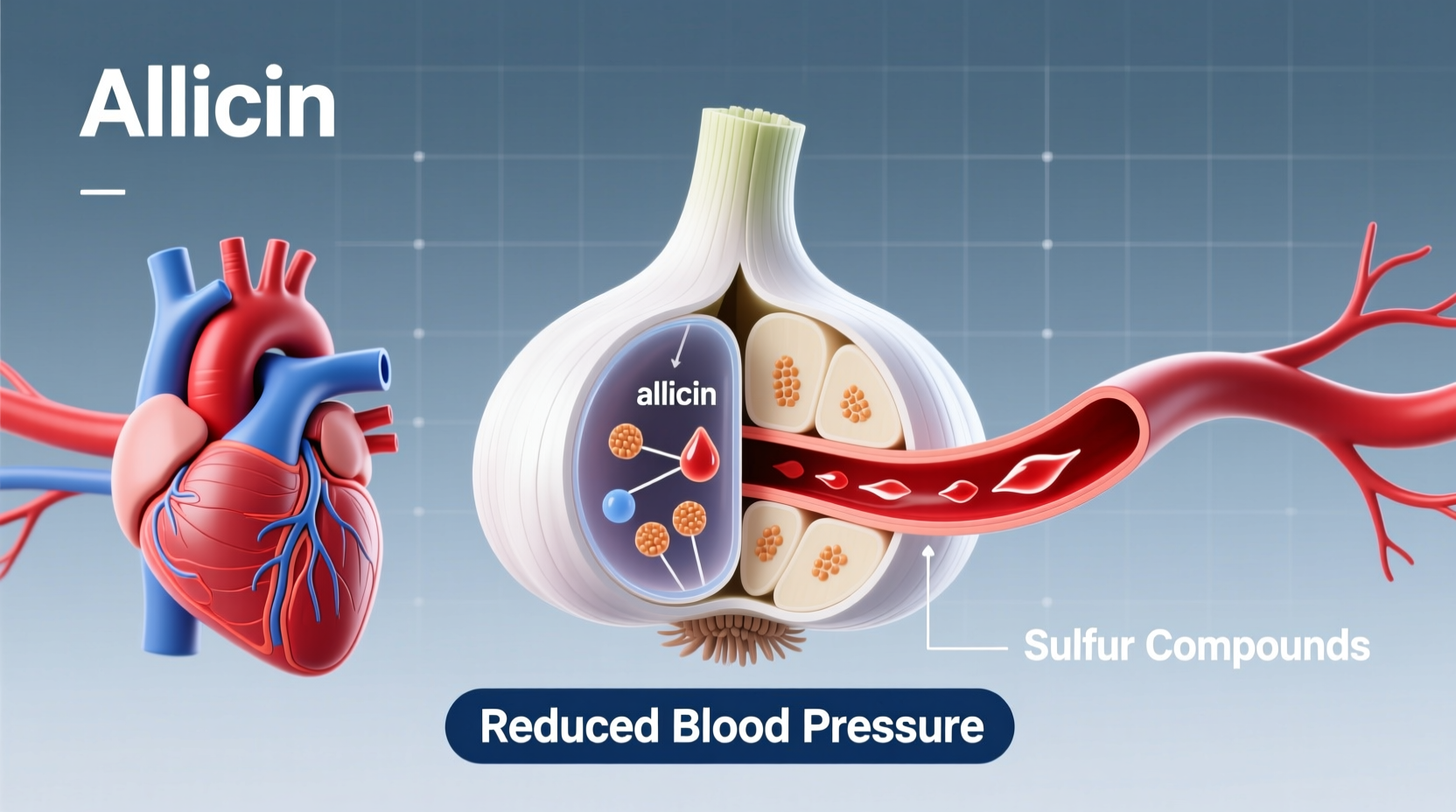For those managing high blood pressure, garlic offers a promising natural complement to conventional treatment. Research published in Integrated Blood Pressure Control demonstrates that regular garlic consumption produces measurable reductions in both systolic and diastolic readings, particularly for individuals with baseline hypertension. Unlike pharmaceutical interventions that often carry significant side effects, garlic provides cardiovascular benefits with minimal risk when consumed appropriately.
How Garlic Works to Lower Blood Pressure
Garlic's blood pressure benefits stem primarily from allicin, the bioactive compound formed when raw garlic is crushed or chopped. Allicin converts to other sulfur-containing compounds that:
- Stimulate nitric oxide production, relaxing blood vessels
- Reduce arterial stiffness through antioxidant effects
- Inhibit angiotensin-converting enzyme (ACE), similar to some prescription medications
- Decrease oxidative stress in vascular tissue
A comprehensive review in the Journal of Nutrition explains that these mechanisms work synergistically to improve endothelial function—the critical lining of blood vessels responsible for regulating blood flow and pressure.
Evidence Comparison: Garlic Forms and Effectiveness
| Garlic Preparation | Allicin Availability | BP Reduction (Systolic) | Research Support |
|---|---|---|---|
| Raw crushed garlic | High (immediate) | 4-8 mmHg | Moderate (short-term) |
| Aged garlic extract | Stable compounds | 5-10 mmHg | Strong (long-term) |
| Garlic powder tablets | Variable | 3-6 mmHg | Moderate |
| Cooked garlic | Low (heat-sensitive) | 2-4 mmHg | Limited |
Source: American Heart Association Hypertension Journal, 2017 analysis of 12 clinical trials
Practical Application: Getting Results with Garlic
For measurable blood pressure benefits, follow these evidence-based guidelines:
Dosage Recommendations
- Raw garlic: Consume 1-2 cloves (3-6 grams) daily, crushed and allowed to sit for 10 minutes before eating to maximize allicin formation
- Aged garlic extract: 600-1,200 mg daily in divided doses (standardized to 1.2-2.4 mg S-allylcysteine)
- Garlic powder: 600-900 mg daily (providing 3.6-5.4 mg alliin)
Consistency matters—research shows benefits typically emerge after 8-12 weeks of regular consumption. The Mayo Clinic notes that aged garlic extract demonstrates the most consistent results in clinical trials due to its stable bioactive compounds.

Important Context Boundaries
While garlic shows promise for blood pressure management, understand these critical limitations:
- Not a replacement for medication: Garlic produces modest reductions (5-10 mmHg) compared to pharmaceuticals (15-25 mmHg). The American Heart Association emphasizes it should complement—not replace—prescribed treatment.
- Individual variation: Genetic factors affect how people metabolize garlic compounds. Some experience significant benefits while others see minimal effects.
- Medication interactions: Garlic may enhance blood-thinning medications like warfarin. Consult your physician before combining with antihypertensive drugs.
- Timeframe: Benefits require consistent consumption for 2-3 months. Short-term use shows minimal impact.
Integrating Garlic into Your Blood Pressure Management Plan
For optimal results, combine garlic with other evidence-based approaches:
- Pair with the DASH diet (rich in fruits, vegetables, and low-fat dairy)
- Maintain regular aerobic exercise (150 minutes weekly)
- Monitor sodium intake (under 1,500 mg daily for hypertension)
- Track readings consistently using a validated home monitor
A landmark study in Phytotherapy Research found participants combining garlic supplementation with lifestyle modifications achieved 12-15 mmHg greater reductions than either intervention alone. This synergistic approach represents the most effective natural strategy for blood pressure management.
When to Consult Your Healthcare Provider
While garlic is generally safe, schedule a consultation if:
- You take blood thinners or antihypertensive medications
- Your systolic reading consistently exceeds 140 mmHg
- You experience digestive discomfort from garlic consumption
- You're scheduled for surgery within 2 weeks (garlic increases bleeding risk)
Remember that hypertension often shows no symptoms until significant damage occurs. Regular monitoring and professional guidance remain essential components of effective management.
Frequently Asked Questions
How long does it take for garlic to lower blood pressure?
Most clinical studies show measurable reductions after 8-12 weeks of consistent daily consumption. Maximum benefits typically appear around 3 months. Individual results vary based on garlic preparation, dosage, and baseline blood pressure levels.
What's the most effective form of garlic for reducing blood pressure?
Aged garlic extract demonstrates the most consistent results in clinical trials due to its stable bioactive compounds. Standardized supplements providing 600-1,200 mg daily show greater efficacy than raw or cooked garlic, which have variable allicin content affected by preparation methods.
Can garlic replace my blood pressure medication?
No, garlic should not replace prescribed medication. While it can produce modest reductions (5-10 mmHg), pharmaceutical treatments typically lower readings by 15-25 mmHg. The American Heart Association recommends garlic as a complementary approach, not a substitute for medication, especially for those with stage 1 or 2 hypertension.
Are there side effects from using garlic for blood pressure management?
Most people tolerate garlic well at recommended doses. Potential side effects include digestive discomfort, bad breath, and body odor. Garlic may increase bleeding risk, particularly when combined with blood-thinning medications. Those scheduled for surgery should discontinue garlic supplements at least 2 weeks beforehand.











 浙公网安备
33010002000092号
浙公网安备
33010002000092号 浙B2-20120091-4
浙B2-20120091-4